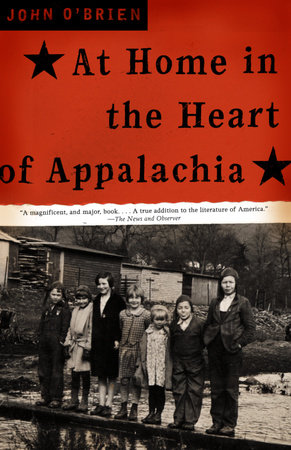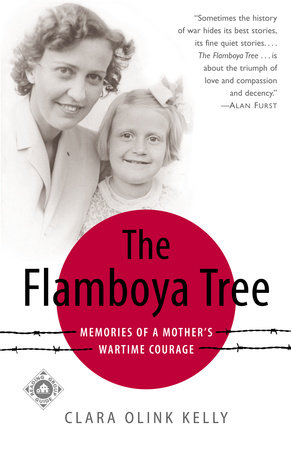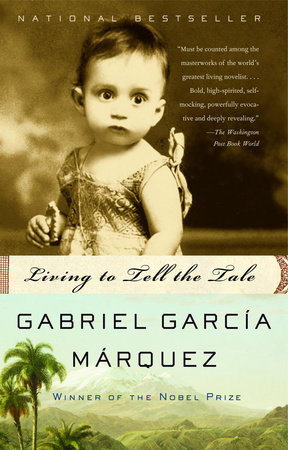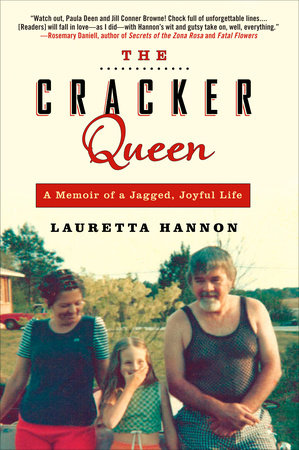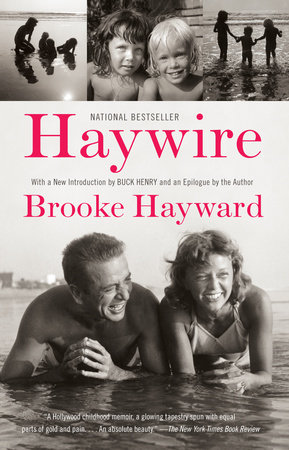Author Q&A
A Conversation with
John O’Brien
author of
At Home in the Heart of Appalachia
Q. Why do you think you had a difficult time "finding" Appalachia?
A. There are really two Appalachias—the place I have always known and the mythic Appalachia most Americans imagine. My Appalachia is lush green mountains, deep forest, ice-cold trout streams, small hill-farms and little towns filled with unpretentious working-class people like my relatives. As I traveled around the country, it became clear that other Americans believed in a strange, woebegone place called Appalachia filled with throwback people lost in poverty, a mythic Appalachia created by backward hillbillies. But where exactly was the place and who was or was not Appalachian?
As I would learn, the region of Appalachia was an arbitrary invention, and its boundaries were arbitrary as well. In some definitions, the region included "the mountainous backyards of nine states" and in others, the backyards of five. As it turns out, determining what it does or does not mean to be Appalachian is as difficult as locating the region itself.
Q. Why did you write this very personal book at this time in your life?
A. Most of the stories, articles and poems that I have written over the years are very "personal"—"close to the bone," some would say. Perhaps my father’s death made my own mortality real, and I became determined to understand his life and my own. I wanted to put parts of our lives on paper. It’s a delusion, but putting down what really happened was like not dying, like my dad and I might live on, if only in a literary sense.
Q. The dynamics of father-son relationships seem to have an important role in At Home in the Heart of Appalachia. Why is that the case?
A. My feelings for my father have always been ambivalent—loving him and needing his approval, but feeling desperate to escape his despair. This was true long before I understood it. The first amateurish story I tried to write was about him. Occasionally, I will start a story about characters and events altogether different and then, through countless revisions, find myself writing about my dad again. I have been preoccupied with my father all of my life; therefore, the fact that he became part of this book is not odd or unusual.
More than that, the best parts of my childhood centered on hunting and fishing with my dad. After being estranged for twelve years, coming home to Appalachia, hunting and fishing in the mountains, and trying to reconcile with my father became part of the same effort.
Q. What drew you back to live in West Virginia?
A. Despite fifty years in Philadelphia, my parents never stopped thinking of West Virginia as home. After my boyhood visits, seven years of college in Morgantown, and marriage to my West Virginia wife, it was home for me as well. For us, life outside the mountains seems brittle and thin. When we became weary of traveling and wanted to settle, West Virginia was the natural choice. Beyond this, we wanted our children to grow up near grandparents, aunts, uncles, and cousins.
Q. Since you first visited Appalachia as a boy, what have been the biggest changes for you and the other residents of the area?
A. Piedmont, my father’s hometown, was a lively working-class town when I was a boy and now the town is dying. When I was a boy in the 1950s, family farms and the small towns near them were alive and well. In a 1950 census, 87% of Pendleton County’s population listed farming as its only source of income. By the 1970 census, however, it was down to 17% and it is even lower now. This pattern holds true across the state and region. As farms failed and land prices plunged, the population declined in Appalachia. Beautiful scenery, a sane, measured life, low taxes, and land at bargain basement prices caught the attention of people in Washington, D.C., and Baltimore. When I was a boy, outsiders—"come-heres" in Pendleton County talk—were rare in the mountains. No longer.
When I was a boy, TV and radio reception was limited to a few local stations in the mountains. Now satellite dishes are so commonplace a commentator has described them as West Virginia’s state flower. This means that Appalachians now watch the same news programs, talk shows, soap operas, sporting events, and commercials that everyone in America watches–and at the same time. In the 1950s many adolescents listened to George Jones, Hank Williams, and Loretta Lynn. Now they listen to Radio Head, In Sync, and the Back Street Boys like adolescents all over the country. Dress styles, speech patterns, and everyday opinions—those things that gave the region its distinct charm— have become more homogenized. Within days after seeing the newest Rap music gestures on MTV, I see them on Main Street in downtown Franklin. I do not see changes like this as good or bad.
Q. What do you like and dislike most about Appalachia?
A. I like the people in the southern mountains, or most of them in any case. People here tend to be unpretentious, straightforward, open, and easygoing. Common sense and commitment to family are common virtues. Appalachians tend to look back more than most other Americans. They define who they are by how they fit into extended family, which includes ancestors. Mountain cultures feel old and deeply rooted. There is a strong sense of place here and I like all of this. And most of West Virginia is simply beautiful.
On the other hand, Appalachians can be extremely provincial and intolerant. The gender roles are limited here. People hold narrow opinions about what constitutes "real" work, proper behavior, and proper dress. An anti-intellectual current runs through small Appalachian communities. It is okay to be smart about making money, fixing cars, farming, or building houses, but there is a general suspicion about "too much deep thinking."
Conditions in the coalfields and chemical communities are appalling. The southern Appalachians was one of the richest and loveliest regions in America. But to drive through the horror of the coalfields and chemical communities and see what rapacious greed has done to the landscape and to the lives of the people is profoundly depressing. Outside coal interests still run the show. Mountains are still strip-mined. The coal and profit leave the state. Politicians controlled by King Coal mouth platitudes, and nothing changes. Politically, Appalachia is hopeless and absurd.
Q. You write that subsistence fishing is the "closest thing to religion" in your life. What do you mean by that?
A. When I was an altar boy, serving mass made me feel that I was part of some grand design, that I belonged in the world in a special way. A feeling much like that comes over me on the river at dusk: Wading knee-deep as the light fades, owls call from the darkness and the water slips against my legs like silk. I feel I am part of something larger.
Q. What role did coal mining have in Appalachia?
A. Asking what role coal played in Appalachia is like asking what role politics played in America. Where does one begin? Coal has affected and continues to affect every aspect of our lives. Between 1885 and 1930, the coal industry, in conjunction with timber interests, swindled thousands of Appalachian families out of ancestral land. As a direct result, 75% of West Virginia’s land and 85% of its natural resources—primarily coal now— belong to outside interests. Outside control of land and resources means outside control of state government; he who pays the Piper calls the tune. State taxes on coal—set by legislation controlled by the coal industry—are absurdly low. We end up with poor roads, underfunded schools, corruption.
In the late 1800s and early 1900s, as coal companies swindled families out of land, the social order in the southern Appalachians collapsed. The unmitigated hell of coal boomtowns created unbelievable squalor and violence. Coal operators blamed all of this on backward culture and feral people. American newspapers accepted this explanation without question. Reporters wrote countless stories about "blood feuds" and "West Virginia savages" that helped create the stereotypes about Appalachians.
In Appalachian coal towns, mining is the only source of employment. This has meant that a vast population has been entirely dependent upon the boom and bust cycle of the coal market for over a hundred years. Families live in company houses on company land and have done so since the 1890s. It is feudal. When the market price of coal plunges, as it often does, thousands of men lose jobs. Large-scale chronic unemployment, it goes without saying, creates profound social problems. Everyone suffers. In short, almost all of the region’s problems circle back to coal.
Q. What role have missionaries played in Appalachia?
A. From 1885 to the present, thousands of missionaries have come into the southern Appalachians and there seems no end in sight. Most missionaries are decent, well-intentioned people who often sacrifice lives of relative comfort to work long and hard to"help" Appalachians. For over a hundred years, they have provided food, medical assistance, emotional support, and spiritual guidance to any number of families and individuals in this part of the country. I find it impossible to hold hard feelings about good-hearted people.
On the other hand, missionaries are blind to their cultural assumptions and they end up facilitating the agendas of the more aggressive—at times rapacious—elements in the dominant culture they come from.
The missionary agenda has always been more social than spiritual. The Appalachian "problem" —the tragic effects that industrialization was having in the mountains—was like the elephant in the living room. The missionaries talked endlessly about how difficult it was to live in cramped quarters, about how to make use of limited space, and better ways to deal with knee-deep elephant shit, but they never talked about the elephant.
Q. For many readers, Appalachia brings to mind L’il Abner, hillbillies, moonshine, poverty, and the Hatfield-McCoy feud. Where do these stereotypes come from, and is there any truth in them?
A. Appalachian stereotypes—Little Abner, hillbillies, moonshine, poverty and the Hatfield-McCoy feud —all began in the 1880s when the turmoil of rapid industrialization, the missionizing effort, and an American literary phenomenon known as the local color movement came together. This is a complex question and I will do my best to be brief.
In the Appalachians, industrialization was lightning-fast and brutal. By 1930 the oldest and largest hardwood forest that human beings will ever know had been clear-cut, and mines had laid waste to large portions of the landscape. When the social order collapsed, men who had been swindled out of land became bitter and often drank too much. Suspicion and mistrust ran wild. The boomtowns, as I said, were just awful. And the robber barons blamed what they had created on backward Appalachians.
The missionaries, who came from the same set of middle-class American families as the robber barons, went along with this. They never interfered with the industrialists, forewarned mountain people, or entered the horrific boomtowns. When the missionaries campaigned for funds—and you must understand how relentless this was, thousands of missionaries speaking in churches and other public forums—they described Appalachians as child-like and backward. The squalor and violence of the boomtowns had nothing to do with the captains of industry—who often made generous donations—but resulted from these strange, sad people and their backward culture.
As the missionary effort expanded, this meant creating the strongest case for backwardness and need, which led to a habit of distortion and exaggeration. In some cases, this meant focusing exclusively on sensational aspects of poverty at the expense of everything that might have been normal or even admirable about the people in the mountains. At other times the missionaries simply lied. Establishing cultural "otherness" was at least as important as establishing poverty.
The local color movement—perhaps thirty writers who lived between 1885 and 1930—wrote stories and books about out-of-the-way "corners" of America. These exotic places were "in America but not, as yet, part of America." The southern Appalachians were close at hand for most writers and the industrialists had built railroads into them.
Between 1885 and 1930, novels and stories about strange hillbillies in the Appalachian Mountains became, as they say, all the rage. As realistic as shoot-’em-up cowboy books or Harlequin romances, these novels should have been harmless diversions, but eager to confirm their middle-class status, nouveau riche Americans read them as journalism. Appalachia and hillbillies became fixtures in America’s imaginary landscape. Hillbilly cartoons appear in major magazines again and again. They also appear in movies and in jokes that are repeated endlessly. In a sense, the existence of cartoonish hillbillies makes the American middle-class feel more secure about their sophistication and arrival. All of this has made mythic Appalachia real in the popular imagination.
And simply put, there was no Hatfield-McCoy feud. In 1897 Governor Buckner of Kentucky invented a "feud" out of two unrelated incidents to ingratiate himself to industrialists who he wanted to come to his state and “save” it. Reporters simply accepted everything local politicians told them and wrote accounts of a "blood feud" filled with feral hillbillies. In point of fact, Appalachian communities were remarkably nonviolent until the onslaught of industrialization began in the 1880s. The stereotypes persist because politicians, missionaries desperate for funds, the media desperate for sensational "news," and the insecure middle-class find them useful.
This kind of thing never stops. Unemployment is extremely high in the coalfields and this creates serious social problems. But the unemployment and the problems have nothing to do with "backward hillbillies." West Virginia, with a per capita income of $18,957, is 49th out of 50 states. Funds for highways and education are seriously limited. But these conditions result from the fact that 75 percent of the state and 85 percent of its natural resources belong to outside interests that control legislation and keeps tax rates low. Conditions in the coalfields —rundown towns, high unemployment, devastated landscapes—are dreadful, but this has nothing to do with mountain cultures.
Q. What do you want the reader to come away from your book feeling about Appalachia?
A. I want readers to understand that mythic Appalachia—hillbillies who have created squalor and are too backward to help themselves—never existed. I want them to know that one of the richest and loveliest regions of America was savagely exploited and that the exploitation continues. Despite this outrage, and the political corruption resulting from it, most Appalachians live in decent, modest homes, own and drive normal cars, care about their families, and go to work every day. Most people who live in the southern mountains are as confused about what "Appalachia" means or what it means to be "Appalachian" as I was before a great deal of research. In fact, most of the people who live in the southern mountains utterly reject the Appalachian label despite loving the region. I would like to put a small dent in the myth of Appalachia.
